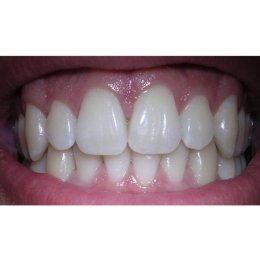
 Dentist-prescribed overnight bleaching is the most effective method of teeth whitening, but it’s very expensive – anywhere from $400 to $900 per treatment, with multiple treatments often needed. Over-the-counter (OTC) whitening agents are a lot more affordable, but do they measure up?
Dentist-prescribed overnight bleaching is the most effective method of teeth whitening, but it’s very expensive – anywhere from $400 to $900 per treatment, with multiple treatments often needed. Over-the-counter (OTC) whitening agents are a lot more affordable, but do they measure up?
Generally speaking, any peroxide-based product can whiten your teeth. The ingredients in OTC kits aren’t as concentrated as the ones the dentists use, so they may take longer to work. Tray-based products and whitening strips are your best bet – they are comparable in terms of side-effects and have been shown to be equally effective in whitening teeth. As an aside, it’s important to note that most of the studies comparing the different products have been done by the product manufacturers, so take them with a grain of salt.
- Tray-based: These products use carbamide peroxide as the bleaching agent. Be careful with the products that contain mouthpieces that aren’t custom-fitted. Because these mouthpieces may not fit snugly, some parts of the teeth may be covered by the bleaching agent, while some parts may not, resulting in uneven bleaching. The leaking can also lead to irritation. If the trays do not fit your mouth properly, they can irritate your gums and mess with the alignment of your teeth.
- Whitening strips: The whitening strips use hydrogen peroxide as the bleaching agent. You typically will see results after a week. Maximum benefit occurs at 2 weeks; using it any longer than that doesn’t seem to add any further whitening effect.
- Paint-on: These whitening agents come as a gel with a small brush, like nail polish. They use peroxide-based bleaching gel like the tray-based agents and you apply it once a day for 14 days. While the paint-on products seem to be as safe as the whitening strips, they aren’t as effective.
- Toothpastes: Whitening toothpastes can help the teeth remain cleaner and therefore look whiter but the stronger ones rely on abrasion to scrub off the outer layer of the teeth – the “newer” layer underneath looks whiter for a while but over time this will actually cause the teeth to lose shine and luster. Aside from the highly abrasive products, the peroxide-based toothpastes are generally safe for daily use although they’re not very effective at whitening teeth. They’re just not on your teeth long enough to do anything, even if you spend a long time brushing. Toothpastes are a decent option for if you’re trying to clean surface stains (e.g. from tobacco, coffee, etc.), but removing deeper stains and changing the color of the internal tooth structures requires professional intervention.
- Chewing gums: There have been no clinical studies to see if these products actually whiten teeth so despite any marketing claims, we don’t really know if they work or not.
The most common side effect of dental bleaching products is tooth sensitivity. This should not last more than a week after cessation of the whitening regimen – if it does, be sure to see a dentist. Gum irritation is more of a problem with OTC bleaching kits, and is mostly due to the bleaching agents leaking around the edges of the mouthpieces. This stuff not only tastes bad, but it can be dangerous if you swallow too much of it. OTC whiteners haven’t been around long enough to say what the long term effects of sustained use are.
If you do decide to use OTC whitening products, use them according to the package directions, stop using them if you experience bothersome irritation, and consult your dentist if you have any questions.
Kelsi Wilkerson (OSU College of Pharmacy)









